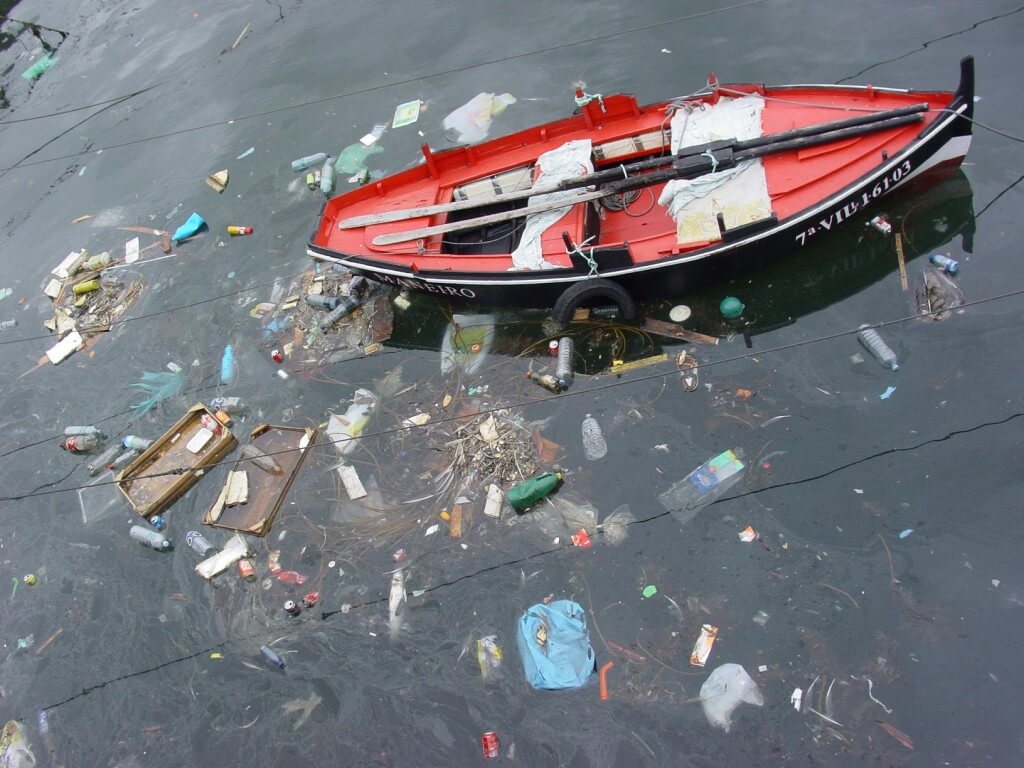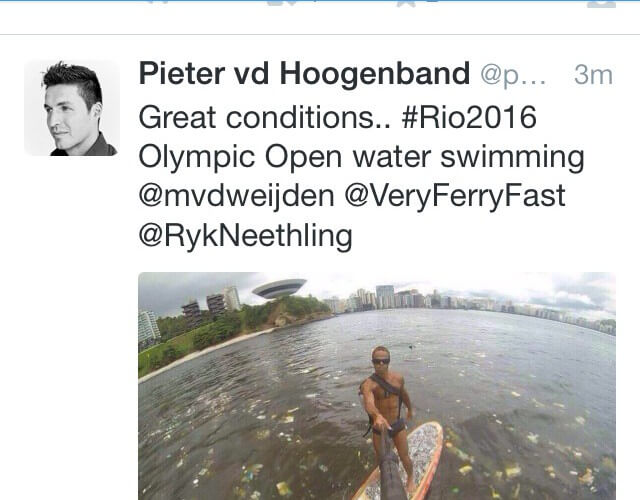Pollution Still Present in Rio 2016 Olympic Venues

Column by Steven V. Selthoffer, Chief European Columnist
RIO DE JANEIRO – In a recent photo tweet from a friend of Pieter van den Hoogenband, the author shows that pollution clearly remains in Rio waters.

Swimming World’ Steve Selthoffer has been following this issue ever since Greenpeace released two reports from their research laboratory that confirms contamination in Guanabara Bay of PCBs, DDT, HCH, metallic contaminants, particularly copper, lead and zinc, present at significant concentrations, combined with evidence of riverine input of mercury and zinc.
This is all combined with the new media online and video reports of tons of raw sewage, industrial and domestic waste, pouring into the bay of which 70% is untreated. The untreated sewage and contaminants flow out the mouth of the bay directly along Copacabana and other Rio ocean side beaches.
The publications released in 2000 and another in 2002 respectively, (without any long term comprehensive cleanup, and current sewage buildup over the past decade in the bay), are no less a concern today than it was then.
Based on the data from the Greenpeace reports and other media stories on pollution contaminants present and measured in Guanabara Bay, it looks like it will not be possible to hold the Olympic sailing event in the bay, and may most likely, cause authorities to reevaluate holding the 10K Open Water Swimming event and the first leg of the Olympic Triathlon at any end of Copacabana beach.
24 hours after Mayor Eduardo Paes stated that the harbor would not be cleaned up in time for the Rio 2016 Olympic Games, “Rio Bay Won’t Be Clean For Olympic Sailing, Mayor Says,” Bloomberg, by David Biller and Pablo Spinetto, Greenpeace released on request copies of their research on the bay that also affects the surrounding beaches, especially Copacabana, directly at the mouth of the bay, home to the Olympic 10K open water swimming event and the first swimming leg of the Olympic Triathlon.
Dr. David Santillo, Greenpeace, International Water Pollution Expert, University of Exeter, UK stated, “It (Guanabara Bay) should be a habitat and natural resource of huge pride and value to Brazil, but that still seems to be far from the case.”
Greenpeace has demonstrated a great concern for the welfare and safety of the Olympic athletes and citizens of Brazil desiring to help make the Rio 2016 Olympic Games a great success. However, Dr. Santillo’s concerns and reports over the years have been largely ignored by the local authorities.
Dangerous levels of pollution confirmed
In a report entitled “Pollution with Organic Tin Compounds, Organchlorines, Hydrocarbons and Metals, in Sediment Samples from Guanabara Bay, Rio de Janeiro, Brazil,” Greenpeace Research Laboratories, Department of Biological Sciences, University of Exeter, UK, 2000, by Dr. David Santillo, R.Stringer, I. Labunska, and K. Brigden, published findings from 14 different bottom sediment samples.
The work identified substantial levels of pollution in 14 sediments collected in August 2000 from various parts of the bay and, though not including water samples, did indicate the scale and diversity of the pollution sources to the bay. The sampling in the reports was done in accordance with U.S. EPA methodologies.
Dr. Santillo stated, “The results demonstrate that the bay is subject to pollution by a wide range of toxic compounds from a variety of sources. Overall, the south and east of the bay are the worst affected areas, although the north and east are not entirely unaffected. All sites were polluted with hydrocarbons and 1,4-dichlorobenzene, which is often found in sewage discharges, which was detected at almost all sites.
Organotins were detectable in all samples analyzed, including the “pristine” north-east of the bay. The predominant source of these identified were the naval and docking facilities in the south of the bay, though some contamination could result from normal shipping traffic. Organotins have long been known to have a severe impact on aquatic ecosystems.
Dock Areas for Sailing Have Most Pollution
Some other metallic contaminants, particularly copper, lead and zinc, were also present at significant concentrations in the dock areas. Moreover, lead appears to be entering the bay in runoff from the city and there is evidence of riverine input of mercury and zinc. The mouth of the Rio Iguaçu exhibits elevations in chromium and nickel, which may be associated with petroleum refining.
Organochlorine pollution is evident at most of the sites sampled, with chlorinated benzenes, PCBs and pesticides or their derivatives accounting for almost all of the contamination. Again, the dock areas were among the most polluted, particularly with PCBs and chlorobenzenes. PCBs and organochlorine pesticides (DDT and HCH) may also be entering the bay via the rivers.”
The findings from those reports, should be a major concern for all governing authorities.
Dr. Santillo then stated, “In our paper from 2002, we concluded that ‘…a more detailed study is needed considering industrial and domestic inputs, since several companies have their effluent being discharged in the Bay. Also, there are uncontrolled dumpsites very close to the shores and untreated sewage transferred directly to Guanabara Bay.”
Reflecting on the issues, Dr. Santillo further stated, “It appears from the latest reports that perhaps rather little has changed since then, and that many of the same problems and concerns remain.”
There have been some media reports stating that authorities think they can move the sailing event closer to the 10K open water swimming venue, to “unpolluted waters outside the bay at its entrance.”
However, there is no such thing as “unpolluted waters at its entrance.”
Depending on the moon and tidal currents, that is where the highest concentration of water-born pollutants reside in highest quantities as the tidal currents condense and pull the toxic and fecal pollution from the mouth of the bay into the ocean directly around Copacabana beach. As the tide comes in, what was sucked out of the bay, is then slowly reversed, dispersed and pushed back onto the local beaches in a tidal swell. It’s called high tide. Any lifeguard and surfer can tell you the story. That is why the beach has been closed a number of times over the years due to pollution alerts.
The BBC reported that “the water quality at Rio’s beaches is assessed weekly by Rio’s Environmental Institute (Inea), and most of the beaches… are repeatedly considered unsafe.”
City water supply on radar
Without a clean, 100% safe sailing, open water swimming or triathlon venue, it now raises concerns with anti-doping testing, not because of athlete’s cheating, but, because of an inadvertent positive analytical findings from contaminants in the city water supply.
We will have more on that tomorrow.
For more information on the Greenpeace reports and findings, please go to:
“Pollution with Organic Tin Compounds, Organchlorines, Hydrocarbons and Metals, in Sediment Samples from Guanabara Bay, Rio de Janeiro, Brazil,” Greenpeace Research Laboratories, Department of Biological Sciences, University of Exeter, UK, 2000, by Dr. David Santillo, R.Stringer, I. Labunska, and K. Brigden.
http://www.greenpeace.to/greenpeace/wp-content/uploads/2011/05/BdeG-report.pdf
THE STATUS OF SEDIMENT SAMPLES FROM GUANABARA BAY RIO DE JANEIRO: A CONTINUOUS STUDY CONSIDERING PCDD/F AND PCB’S CONTAMINATION; Gabriela Kernick Carvalhaes, Laboratory of Environmental Control, Rio de Janeiro, 2002.
http://www.greenpeace.to/greenpeace/wp-content/uploads/2011/05/3-357.pdf



